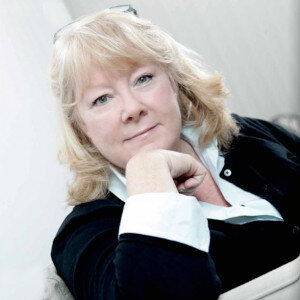Koann Skrzyniarz: The Road to Being a Sustainable Brand
How proponents of sustainability prove the value of a triple bottom line — people, planet and profit. The founder/CEO of Sustainable Brands offers the research and the rationale.
“The notion of ‘good growth’ is today’s reality. The market conditions are such that more and more stakeholders are starting to really understand the problems we face and to both expect brands to do something different, but also reward them for that.”
By E.B. Moss
Marketers are used to the need to clearly convey a value proposition. Some brands, per Carl Fremont’s POV in this issue, do that better than others.Take a look at some of the news on the Sustainable Brands web site and you’ll read how executives at Nike and Chipotle are now getting compensated on a new set of environmental and social goals. And, that MasterCard is launching a credit card that rewards card holders for shopping at women owned businesses; or that Visa's Virginia data center will be 100% renewable energy powered within the next five years. What’s led to many of these initiatives and stances?
KoAnn Skrzyniarz has been making a strong case for Sustainable Brands by leading the global conversation with some of the world’s biggest advertisers around the business value of environmental and social purpose. In a more local conversation with The Continuum, KoAnn (frequently known by just her first name) focused on not just the whys, but some recent “hows”: how sustainability has moved the needle for leading brands and how to be resilient in a “VUCA” world. A what? Read on.
Explain the impetus for creating Sustainable Brands – and if its mission has changed over its 15 years?
In April 2002 I had the chance to hear Bill McDonough [author, Cradle to Cradle] speak at a NASA event. After systemic exposure to the role of business in impacting society and our environment, it sparked for me. I became interested in catalyzing brands as an engine for innovation and a means of getting to the future we want. So, I would say the mission has not changed one iota, but definitely tactics have changed – because the market has changed, thankfully, and that's exciting for all of us.
What kind of changes have you seen in the marketplace?
Twenty years ago it was not recognized that companies that understood how to innovate for environmental and social benefit were going to be the companies that survived and thrived in the 21st century. So when we began, it really was about aggregating those parts of the company that really understood those market drivers or the environmental and social drivers, which were usually sitting in environmental health and safety offices, or corporate social responsibility offices. We were trying to help them understand that they had the potential to be a more strategic asset to the company by connecting what it is they know to the core brand value of the business.
That has taken almost two decades to both enable that stakeholder group that we originally brought together, equip them to understand how to talk marketing and innovation, and to then attract marketers and innovators to the conversation.
It’s really key that the three legs of the stool work in concert with each other in order for there to be effective business value created as well as impact at the same time.
I know you’ve said in the past that “Corporate Social Responsibility,” or CSR, sounds too burdensome as a phrase. What phrases do you use today?
I just talk about [sustainability] as an engine for growth and future-proofing a brand. And the ANA [Association of National Advertisers] has picked up on this moniker, too: the notion of ‘good growth’ – which is today’s reality. The market conditions are such that more and more stakeholders are starting to really understand the problems we face and to both expect brands to do something different, but also reward them for that.
It's more of the carrot than the stick?
There's always a value in the stick helping nudge people along or making sure that they stay within the proper authentic guardrails. But at the end of the day, if we don't catalyze a shift in our economic engine, we're not going to sustain the work that we need to do. So, we're really interested in the virtuous circle, to create the economy that supports us all for the long term.
“Oftentimes the sustainability teams have been doing a lot of the heavy lifting and pointing people in the right direction. But that work is starting to slide into other parts of the house, which is great. Ultimately we're talking about transitioning whole businesses, and the way things are done as a company.”
Tell us more about the roles of those three legs of the stool.
Our core constituency that needs to be in lock step are the sustainability folks who understand the real challenges that we face societally and as the planet. Sometimes they still sit in separate groups. There still are the social responsibility or corporate responsibility teams. And, far too often we find the sustainability teams only tackling environmental issues; but we see them as intrinsically connected. That's one leg.
Brand marketers and brand strategists who own the market and the customer, and the product and service positioning, and how that product and service is built out, is another leg. And then the innovation teams who are there to help look at new ways to enable better brands through materials and packaging innovation, and even business model innovation in some situations.
Oftentimes the sustainability teams have been doing a lot of the heavy lifting and pointing people in the right direction. But that work is starting to slide into other parts of the house, which is great. I mean, ultimately we're talking about transitioning whole businesses really, and the way things are done as a company. And at the same time we’re transforming through brand messaging and communications what our culture aspires to and how we as consumers think about what the good life looks like – and how we want to engage with brands, and which brands we even want to engage with.
How are our more recent waves of passion – beyond the impact of an inconvenient truth, but an inconvenient pandemic – and getting more “woke,” if you will, around social injustices, especially the very activated younger generation, impacting consumer demand for brand purpose?
Sometimes people ask me, ‘Is this just another trend? How does it compare to the green rush of the 2007 timeframe?’ The level of interest and engagement in any given topic is naturally somewhat connected to news cycles and what's in your face every day, and that's normal. However, there’s more of an understanding about the connection between environmental challenges and social challenges. And companies are seeing these moments as an opportunity for coming to grips with risk and looking for opportunities to innovate.
In 2007, partly as a result of An Inconvenient Truth, and partly as a result of Hurricane Katrina with a lot of active brand activation and business engagement in support of that, brands did get ahead of their skis in talking about their commitment to being green. They took the backlash from claims of greenwashing and maybe stopped talking, but mostly they actually kept doing the work.
Today, with a new crisis at the table, the companies we have worked with since then are way more sophisticated in their own internal operations, in their understanding of the landscape and systems. They're able to take these moments and build on the work that they've been doing for the last decade. So there definitely is going to be forward progress. We have all kinds of data around that.
Speaking of data, the marketing industry always wants to understand if there's a bona fide ROI against supporting initiatives such as being pro-social or, as Rishad Tobaccowala calls it, having a brand soul. So what kind of proof is in the pudding?
There's so much data supportive of sales driven by environmental and social value propositions. You see all kinds of smart brand transformation happening at many different companies who are perhaps redesigning existing brands to be more environmentally or socially positive, or buying direct-to-consumer brands to improve their portfolio, repositioning brands to have a better statement about an existing value proposition that they haven't really leveraged.... Just many ways that companies are starting to drive more value and more sales out of this positioning.
I believe you built out a SB Brand Transformation RoadmapSM. Are you still using that? And who are some brands that are on that road?
Yes. The reference I just made to buying or repositioning came from a Clorox Company model back in early 2008. Brita water filters was a repositioned product speaking to the plastics problem. They acquired Burt's Bees, and Greenworks was the largest invested launch in their history at that time.
I was also just speaking to Marc [Pritchard of P&G] about how I was at Target, one of our other partners and favorite retailers, and saw the launch of their Planet KIND brand. It's a beautiful example of a new innovation from Gillette that has gorgeous packaging, and a great environmental value proposition message attached to it. And P&G bought Native Brand deodorant, which is another product I love and use. You put that alongside Tide Cold Water and other brands like their Herbal Essence innovation that's focusing on biodiversity, and you start to see a multi-tiered approach to transformation of a whole family of brands.
We’ve all had to do the proverbial pandemic pivot, but taking your global conferences virtual must have been a big shift. What have been some pros and cons and advice you would give others?
We do generate quite a bit of revenue from events and catalyze community through face-to-face events. The upside of the virtual experience is that we were able to reach and engage with many more people last year and our NPS scores have been super strong. I think that that net result will be a larger pipeline to pull people into our work.
We bumped back our U.S. flagship event to this fall. And we just ran our first hybrid event in the world in Yokohama. That was the last face-to-face event we ran – in February of last year as the quarantined cruise ship was sitting off shore, out the window of our event. So, it was nice to get back a year later to convening people face-to-face and to recognize that you can do both.
I just keep telling my team about resilience in a VUCA world. The term VUCA means a Volatile, Uncertain, Complex, and Ambiguous world, which is something that will be the case for some time longer, certainly for in the coming years as we transition into new economic models that we can use to sustain ourselves on this planet going forward. It helps to be flexible when change and disruption happens – and there will be more of it. Necessarily so.
Are you hopeful in our current political environment for sustainable change?
I continue to be troubled by the polarity in the world today. And I think that whoever is in charge has got to build a stronger muscle around learning to listen and empathize and hear people who, by and large, are saying more of the same thing than, than not. But, we have just developed a habit of using people's words against them instead of probing underneath the words to understand what's really meant. I think we have a lot of work to do on both sides and individually in our communities, even in our families.
We'll get there.
March 30, 2021




